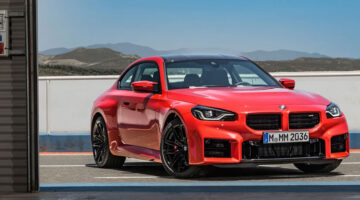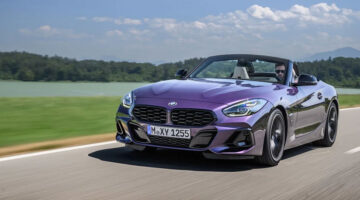Seventh gen 3-series is most advanced yet to take on Audi A4 and Mercedes C-class. New M3 set for 2020
BMW has revealed the seventh generation of its 3-series saloon at the Paris motor show as it looks to continue to battle Audi’s A4 and Mercedes-Benz C-classhead-on in the executive saloon sector.
On sale from 9 March 2019, prices for the new BMW 3-series will start at $43,700 for the rear-wheel-drive 320d. The initial range-topper, the 330i, will start from $49,000, with the line-up set to be completed with the introduction of three- and six-cylinder petrol engines, a number of hybrid options and eventually a full-electric 3-series, called the i4.
Two gearbox and drivetrain options will be offered at launch, with rear-wheel drive standard and BMW’s xDrive four-wheel-drive system offered as an option, including on the 320d. The outgoing car’s six-speed manual gearbox is retained having been thoroughly overhauled; an eight-speed Steptronic auto will be available as an option.
For the launch of the new 3-series BMW will offer two four-cylinder petrol engines and a single diesel engine. The latest generation of 2-litre TwinPower petrol and diesels will contribute the bulk of BMW 3-series sales, with the diesel receiving a thorough workover to guarantee it reaches the latest emission and economy targets, the result of which sees a power increase to 187bhp with a maximum torque figure of 295lb ft.
In terms of petrol engines, the 2-litre four-cylinder fitted to the 330i models is carried over from its predecessor, but thanks to its lighter construction it will reach 100kph in 5.8sec. Its top speed will be limited to 249kph.
Further additions to the engine line-up will be three- and four-cylinder petrol units along with the latest version of the 254bhp 3-litre six-cylinder petrol engine currently fitted to the 540i and the new Z4 Roadster. The new 340i M Sport will be aimed squarely at Audi S4/S5 and Mercedes-AMG’s C43 models, with power and performance expected to top both. A 3-litre turbodiesel will also join the range along with two plug-in hybrid models; a 330e iPerformance followed by a smaller-capacity 325e. A full-electric powertrain, which will go in the i4, will also join the 3-series family.
With regards to the next M3 it will be given a further evolution of the current M4 engine’s twin-turbo six-cylinder motor with power expected to be in the region of 480bhp – a 50bhp increase on the outgoing car. The company’s 1.5-litre, three-cylinder petrol engine will kick things off at the other end of the line-up.
While the powertrains have been mildly tweaked on their way from old to new 3-series, the rest of BMW’s compact exec is all new. The body in weight is 25kg lighter, the front suspension and engine subframe save a further 7.5kg and the aluminium body panels save an additional 15kg. Depending on the model you go for the new 3-series is up to 55kg lighter than the outgoing car.
It’s also longer (by 85mm), wider by 16mm and 1mm taller. The wheelbase has been stretched by 41mm and the front and rear tracks are 43 and 21mm wider respectively. The increase in size is to not only provide more interior space, but to improve the car’s dynamics.
On the chassis front, the body is 25 per cent stiffer (nearly 50 per cent in some areas) and the suspension mounting points have been stiffened, too, with spring rates 20 per cent stiffer. BMW’s M Active differential will be optional on M Sport models.
Two trim lines will be available at the car’s launch – SE and M Sport (the latter expected to continue to be the biggest seller) – with both fitted with passive dampers as standard and BMW’s M active damper system available as an option. M Sport models also receive a 10mm drop in ride height, while the 330i M Sport is equipped with BMW’s M Performance brakes as standard.
The new BMW 3-series look is a further evolution of the company’s current design language, so while it breaks no revolutionary design grounds it will be comfortingly familiar for many. An improvement in aerodynamics has been achieved through more intelligent use of active aero design at the front of the car and a more efficient design of the car’s air curtains in the front bumper. An almost entirely flat floor and more aerodynamic wheel designs all contribute to reducing the car’s drag figure from 0.26 to 0.23.
If you are looking for grand design changes on the new 3-series you’ll need to look inside, which is a further evolution of the interior of the new X5, 8-series and Z4 down to the 10.5-inch TFT instrument display. There’s also more interior space and high-quality materials used throughout.
Coinciding with the new 3-series launch is BMW’s latest rationing of options, which has resulted in six individual option packages being offered and only a further ten standalone options to choose from. This is in response to the latest WLTP regulations which require manufacturers to test every model in every configuration and trim available. Naturally, a new 3-series Touring will arrive soon after the saloon reaches the showrooms, so too a new 4-series coupe.
This article originally appeared at
evo.co.uk






